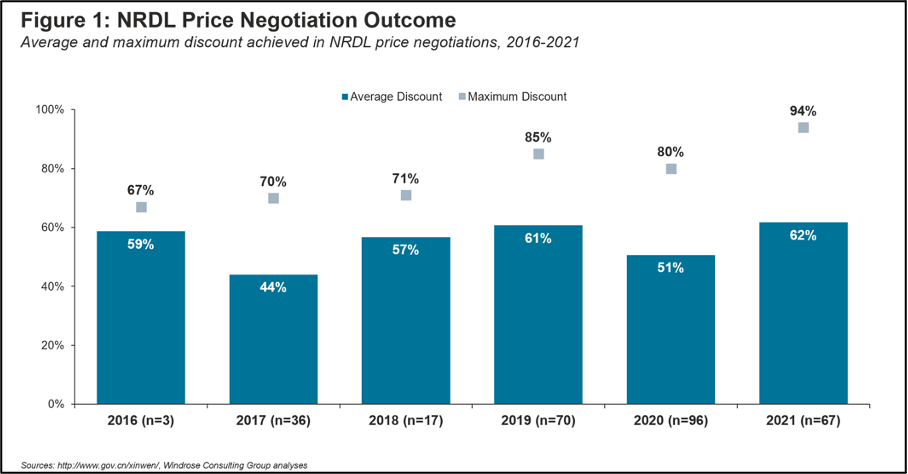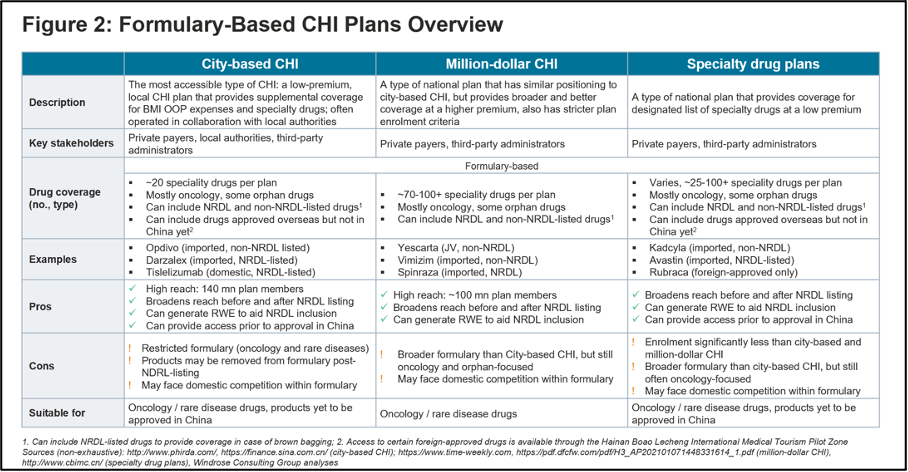The Emergence of Commercial Health Insurances as an Access Route to the Chinese Market
Commercial Health Insurance may bring more opportunities for market access in China.
Anais Frappe

China has historically been a challenging market for foreign healthcare manufacturers to achieve successful Market Access & Pricing (MA&P) outcomes for their drugs. The recent elimination of the Provincial Reimbursement Drug Lists (PRDL) has made the National Reimbursed Drugs List (NRDL) the sole route to public funding in China. Yet, while NRDL inclusion remains the only route for national public reimbursement, the path to NRDL inclusion has grown tougher.
Drugs need to pass a series of formal reviews prior to NRDL negotiations, and if manufacturers succeed in passing these stages, they are then expected to provide significant discounts on their pre-NRDL price during negotiations [see figure 1]. In addition, domestic products have grown in number and are undercutting multinational players on price.
Amy Morgan

NRDL Price Negotiation Outcome

Under this backdrop, in tandem with growing government support, Commercial Health Insurance (CHI) has emerged as a key pathway to provide access prior to gaining national public reimbursement or even prior to regulatory approval.
In this article, we explore market access opportunities in China through private payers, and how CHI can bring value before, during, and after NRDL inclusion. We particularly focus on formulary-based health plans which require active engagement with stakeholders (i.e., private payers and Third-Party Administrators (TPA)) to achieve access, including city-based CHI, million-dollar CHI and specialty drug plans. Other types of CHI plans are not included in the scope of this article.1
Definition and types of formulary-based CHI
CHI plans have been operated in China for decades2 to increase access to healthcare and innovative medicines, improve overall affordability, while simultaneously decreasing the pressure on the government to provide access. CHI plans can be defined as voluntary insurances offered by private payers that provide healthcare coverage on top of the statutory Basic Medical Insurance (BMI). As of today, several types of formulary-based CHI exist [see figure 2] that can be leveraged by manufacturers seeking to launch a drug in China:
- City-based CHI | City-based CHI, or "Hui Min Bao”, have been gathering strong momentum over the past few years. City-based CHI are low-premium, local plans that provide supplemental coverage for Basic Medical Insurance (BMI) Out-of-Pocket (OOP) expenses and specialty drugs
- Million-dollar CHI | Million-dollar CHI are a type of national plan that has similar positioning to city-based CHI, but provides broader and better coverage at a higher premium
- Specialty drug plans | Specialty drug plans are another type of national plan that provide coverage for a designated list of specialty drugs at a low premium
CHI plans also take different forms. City-based CHI are typically public-private partnerships (PPP) between insurance companies, TPAs, local governments, and/or local branches of the National Healthcare Security Administration (NHSA); whereas others are operated solely by private payers.
Recent City-based CHI have continued to build on the PPP model, leveraging close collaborations among the leading commercial insurance companies, local government agencies, and TPAs who act as a go-between for private payers and manufacturers by actively participating in the design and management of drug formularies. In that, collaborating with TPA can help secure inclusion of a drug in multiple CHI plans.
Formulary-Based CHI Plans Overview

Benefits of formulary-based CHI
The benefits of formulary-based CHI can be realised before, during, and after NRDL inclusion.
Pre-NDRL, and given affordability constraints in China, formulary-based CHI offers a means to improve access to drugs to patients who might otherwise not be able to afford out-of-pocket. Considering the median annual disposable income is ~$4,300 per capita, most specialty drugs, if self-paid, are out of reach for the masses.3 While CHI penetration remains low, it represents a sizable population: as of 2021, city-based CHI plans provided coverage for 140 million citizens whereas million-dollar CHI plans provided coverage for 100 million citizens.4,5
During the NRDL listing process, formulary-based CHI plans can facilitate NRDL inclusion by allowing manufacturers to engage with physicians and patients, as well as collect RWD to support the NRDL listing application. Indeed, while pricing is a key component of the NRDL negotiations, <50% of drugs that applied get through to the negotiations stage: prior to these, drugs need to be selected for negotiations, and the selection is based on clinical and economic assessments.6 As such, ensuring support from Key Opinion Leaders and patient advocacy groups can help secure a spot at the negotiations table. As for RWD, these can become instrumental for understanding local epidemiology, treatment patterns, and duration in clinical practice. This enables manufacturers to paint a more accurate picture of efficacy in real life, expected uptake, and eventually of the budget impact forecast which will be paramount to NRDL negotiations. In addition, this represents an opportunity for manufacturers to gauge market reaction before committing to NRDL listing with a significant price discount.
Post-NRDL listing, CHI plans can provide further relief on the burdensome OOP expenses that remain after public reimbursement. For instance, statutory health insurance is estimated to account for only ~35-45% of overall oncology specialty drug payments,7 leaving patients to cover most of the outstanding costs. CHI can play an important role in ensuring broad access after NRDL inclusion.
Conclusion
As formulary-based CHI are becoming an integral part of the Chinese market access landscape and opening a new window for innovative therapies planning for launches in China, their multiplication and development can also add complexity for drug manufacturers. Indeed, multiple plans exist so that no single scheme fits all. In this context, it is critical for pharmaceutical manufacturers to evaluate their capacity to utilize CHI, either as an interim solution in advance of proceeding with an NRDL listing strategy or as a long-term approach in the absence of NRDL listing.
About the authors
Anaïs Frappé is a Principal at Windrose Consulting Group in London. Amy Morgan is Windrose’s Head of International Markets. The article also leveraged Crystal Leung’s (Senior Analyst at Windrose Consulting Group) support and knowledge.
Sources:
- Single-condition plans cover multiple drugs indicated for a specific disease, and associated medical costs such as inpatient stays, whereas mid- / high-end plans provide unrestricted coverage for reasonably prescribed medicines, as well as inpatient and outpatient coverage on top of BMI
- CHI, under the general scope of the insurance industry, was formally recognized by the Chinese government with regulations and related policy in 1998
- http://www.stats.gov.cn/english/PressRelease/202201/t20220118_1826649.html
- http://www.phirda.com/artilce_28021.html?cId=1
- https://www.time-weekly.com/post/291785
- http://www.gov.cn/NHSA
- https://www.sohu.com/a/420060615_308956